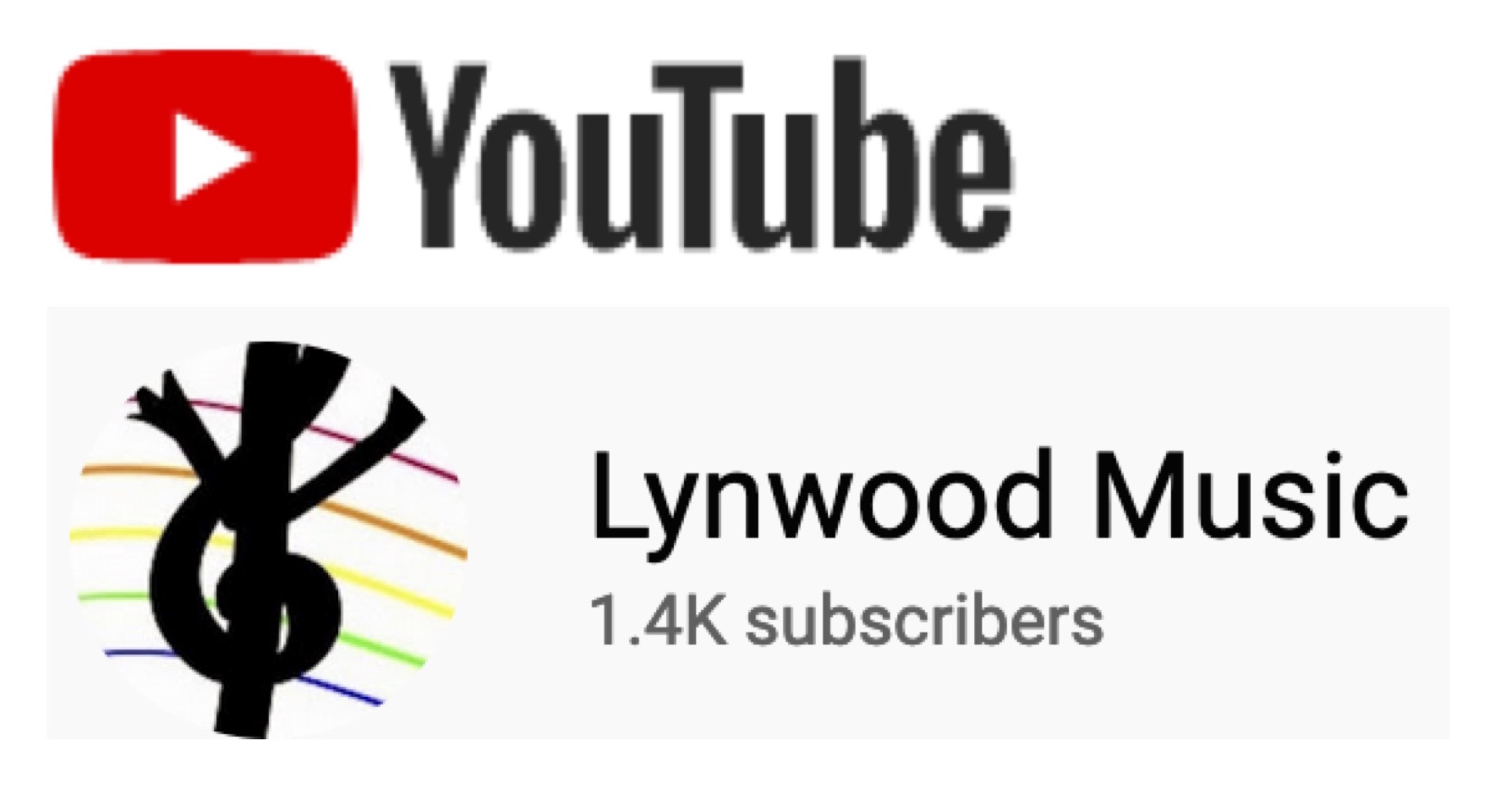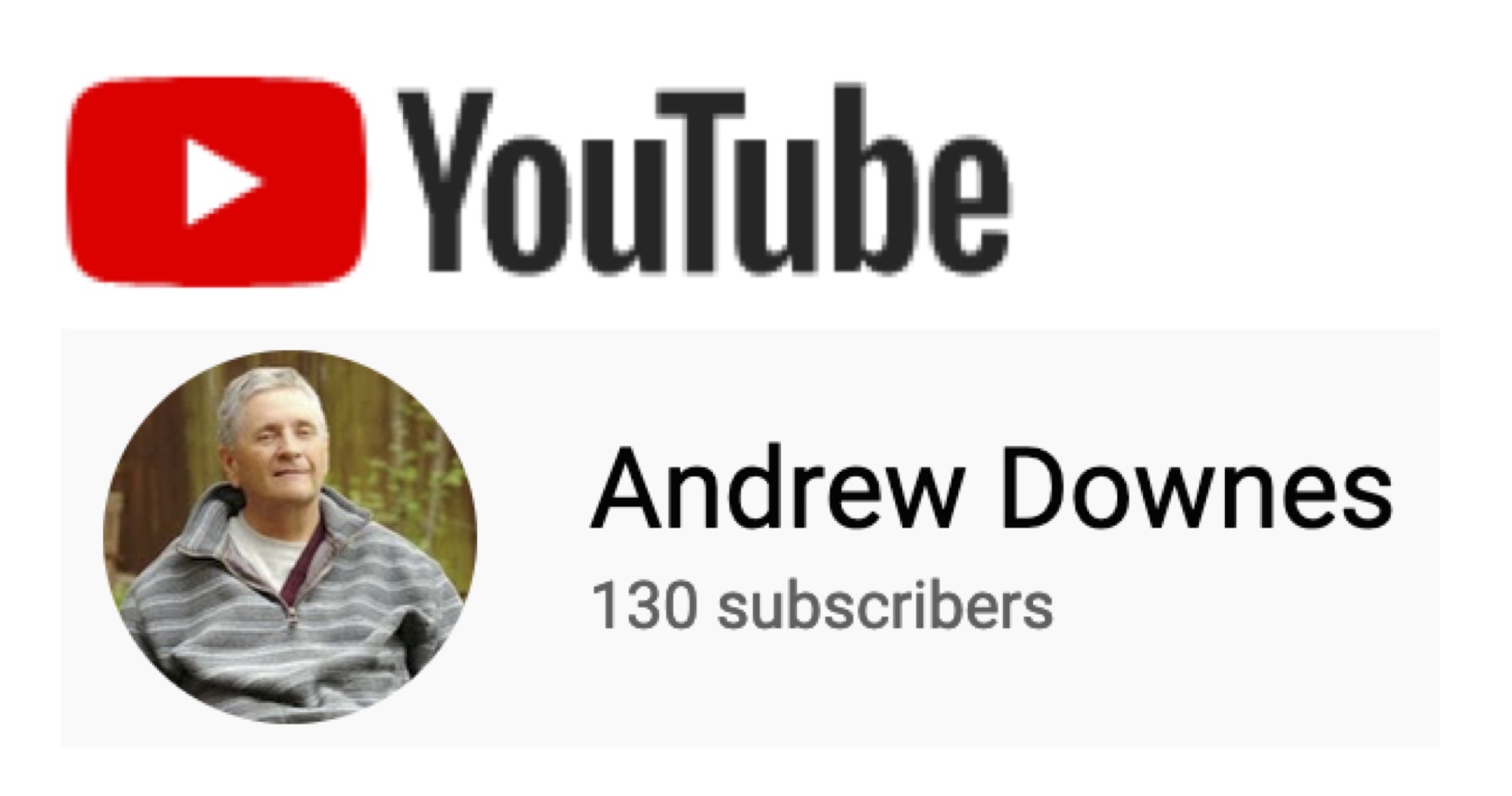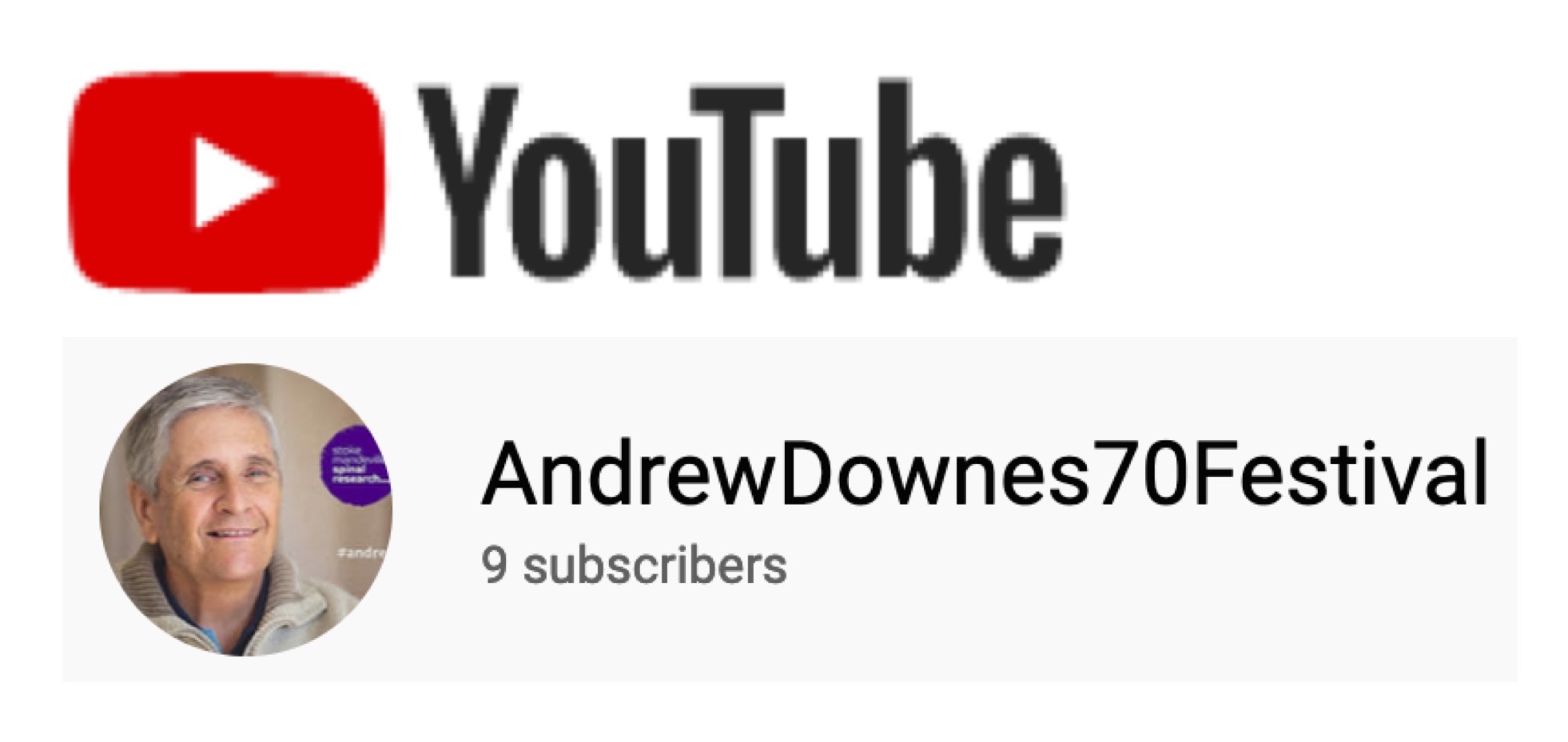Back to andrewdownes.com

Music Education
Resources by Paula Downes, a lot of music by Andrew Downes
Articulation
On this page:
Introduction and basic articulation
Woodwind and Brass
Strings
Guitar
Harp
Bowed strings
Piano
Percussion
We can play notes smoothly, detached, or accented, and depending on which instrument we are playing, we can pluck, bow, flutter-tongue, mute, or stop, to name just a few examples. We generally use italian terms and symbols to indicate the type of articulation to be used as you will see below.
Legato - smooth, linked, italian for 'bound'. Musicians play legato unless told otherwise.
A slur indicates that the notes underneath the slur should be played smoothly.
Slurs can go above or below the music. As a general rule, they go above the note heads when most of the stems go down, and below the note heads when most of the stems go up. Here is a slur:
Here is a passage of music with slurs:

A violinist will play all of the notes under a slur in one bow and will then most likely change bow at the end of a slur, or stop the bow from moving at the end of the slur:
A woodwind or brass player will 'tongue' (make a 't' against the roof of their mouth) at the beginning of a slur and then not tongue the rest.
Start this video at 36:19 and end at 36:30 if it doesn't automatically do so.
A singer will stay on the same syllable during a slur:
Singers and woodwind players must not breathe during a slur.
In music of the Baroque and Classical eras, a slur can also indicate that the first note of the slur is the loudest and the last note is the quietest, with a decrescendo between them.
A phrase mark, which looks very similar to a slur, but which is used to indicate the start and end of a phrase, can also indicate that the music should be played legato. There should be a breath, or a pause similar to a breath at the end of a phrase mark.

Staccato - short, detached. The note should sound for half the value. Staccato is indicated by dots above the note head when the stem is going down, and underneath the note head when the stem is going up:

Mezzo Staccato - slightly longer notes than half of the value. This can be indicated by a slur with dashes or dots underneath, and string players will play the notes in one bow, stopping the bow at the end of each note:


Staccatissimo - extremely short staccato, played with spiccato (see under bowed strings) if played by a bowed stringed instrument. Staccatissimo is indicated by a wedge above the note head when the stem is going down, and underneath the note head when the stem is going up:

An accent tells a player to play the beginning of the note with force. An accent looks like this: > It can go above or below the note:

Sforzando (sfz) - play the note with sudden, strong emphasis, similar to the accents above.
Rinforzando (rf), (rfz) - suddenly reinforced/stronger, similar to the accents above.
Marcato - a passage is to be played accented, with force at the start of each note, marked. Marcato is indicated either with the word marcato, with this symbol above each note: ^ It can go above or below the note:

Tenuto (ten.) - hold each note for as long as possible. Tenuto is indicated by the word tenuto or ten. above the passage of music, or by tenuto marks, which look like this: - They generally go above the note head when the stem is going down, and underneath the note head when the stem is going up:

Glissando and Portamente - the player should slide between two notes. String players (of fretless string instruments), trombonists and singers can slide, but pianists and, harpists have to play every note rapidly between the two notes. Woodwind and brass players can slide to a certain extent by blowing increasingly more forcefully. Glissandos and portamentes are indicated as follows:

An example of a harp glissando:
Stop this video at 7 seconds if it doesn't automatically do so.
An example of a saxophone portamente:
Tremolo - trembling the bow on the strings, or rolling on a percussion instrument, or rapidly plucking on a harp or guitar, or rapidly alternating between two notes on any instrument. The number of slashes through a note stem indicates how many times the note should be articulated for the duration of the note. One slash means play quavers/eighth notes, two slashes mean play semiquavers/sixteenth notes, three slashes mean play demisemiquavers/thirtysecond notes:

Vibrato - oscillating above and below the pitch of a note.
Harmonics - light, feathery sounding notes, produced in different ways by different instruments. Harmonics are present in every note, but using the following techniques, we can actually produce them by themselves.
Most of brass players' notes are harmonics. Their instruments are tubes coiled up. The lowest note they can produce is called the fundamental, and then they blow harder or softer to produce the different notes/harmonics present above that fundamental. If the player presses down the valves, the tube becomes longer, therefore producing a different fundamental and a different set of harmonics. Trombones are different, in that the tube is extended with a slide, not valves.
Woodwind players also produce their notes by blowing down a tube. The more fingers they put down, the longer the tube. If they blow a little harder, they produce the notes an octave higher (eight notes higher), which is the first harmonic in the series for each pitch. Other harmonics can be produced as a special effect if the player blows harder still.
String players can press their finger more lightly on the string in certain places to produce harmonics. This is a special effect, since they can produce the same note 'properly' elsewhere on the instrument.
Mutes - instruments can either be muted by the players hands or fingers or by an object called a mute. The Italian term for this is con sordino (with mute), and this is written above the music. Senza sordino means 'without mute'. A mute cuts out a lot of vibrations on the instrument, changing the timbre and making it quieter.
On a bowed stringed instrument, the player will put a mute onto the bridge to stop vibrations travelling from the string to the body.
On a guitar, players can mute the sound by covering the strings with the side of their hand. Some electric guitars have built-in mutes to acheive the same effect, or to create a more percussive sound.
On a brass instrument, mutes are put inside the bell or hung or clipped to the outside of the bell. There are a variety of mutes made from different materials to change the sound in different ways.
French Horn players also 'stop the sound' by putting their hand inside the bell of the horn, creating a buzzing sound a semitone higher.
Woodwind mutes are rare, occasionally they will stuff a handkerchief up the instrument to muffle it.
Saxophones sometimes use mutes to soften the sound.
Percussion instruments are muted by gripping with the hand to stop vibrations (eg triangle), or by laying cloth or other materials over drums, or by running fingers across an instrument to stop vibrations (eg timpani). Percussionists can also mute by holding or striking the instrument differently. A note that is to be muted in percussion music is often noted with a x for the head of the note.
The symbol for a harmonic is the same as the symbol for an open string on a stringed instrument. This means play the open string (no fingers of the left hand pressed down) to produce the note, in order to produce a more ringing, piercing tone, rather than putting a finger down on a lower string. The symbol is a small circle above the note head when the stem is going down, and underneath the note head when the stem is going up:

A fermata or pause tells the player to hold a note for as long as they like. They generally go above the note head when the stem is going down, and underneath the note head when the stem is going up. A rounded fermata is the most common symbol, the three-edged fermata is an extra long pause, and the two-edged fermata is a short pause :
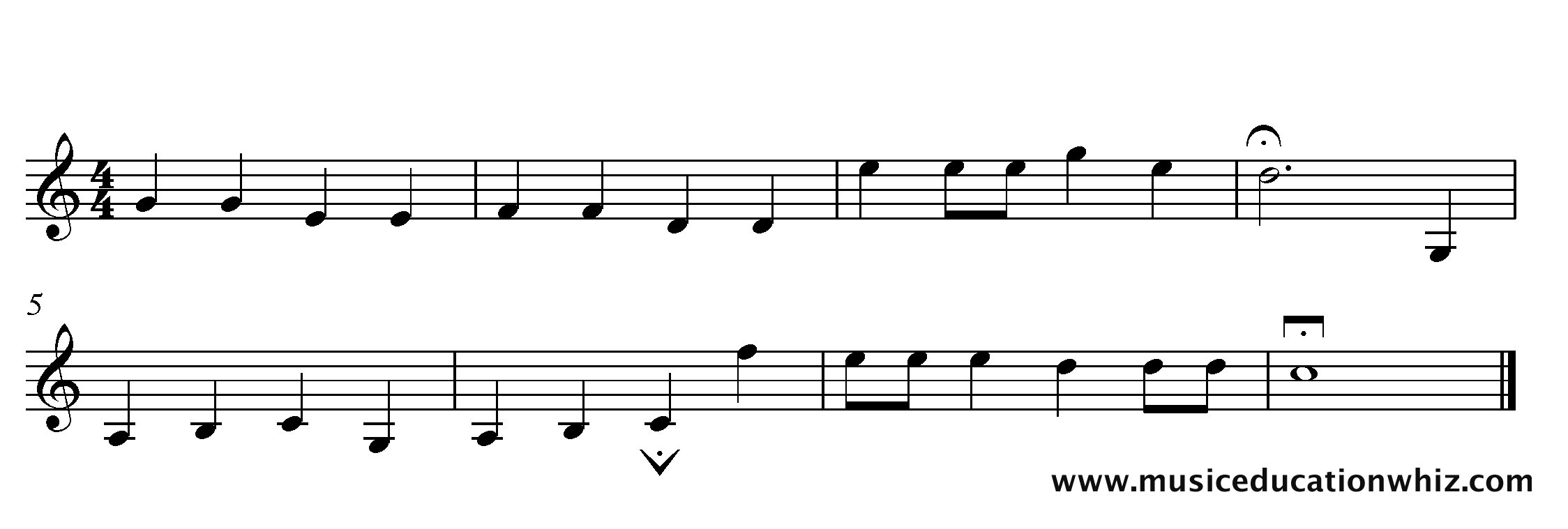
Silences - these all usually go above the music:
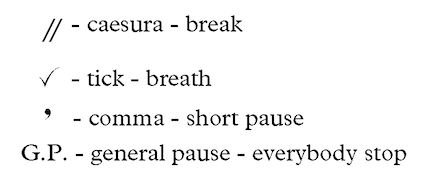
Watch the video below to see examples of some of these articulations:
Woodwind and Brass Articulation
Woodwind and brass players articulate different notes by 'tonguing'.
Flute and brass players do this by saying 'tooh' or 'ta' or 'da' inside their mouth:
Start this video at 32:16 and end at 36:38 if it doesn't automatically do so.
Reed players (eg clarinet, oboe, saxophone, bassoon) say 'tooh' or 'ta' or 'da' against the reed:
Double and Triple Tonguing - brass players (and sometimes woodwind players) use syllables of 'dig' guh' in rapid succession, or 'tuh' 'kuh', or 'tih' 'kuh' for passages of fast notes:
Flutter-tonguing - wind and brass players roll their tongue as they blow into their instrument.
Start this video at 2:17 and end at 2:21 if it doesn't automatically do so.
Strings Articulation
Pizzicato - string players pluck the strings instead of bowing. This indicated by pizz. above or below the music.
Snap pizzicato - when a string player pulls the string up and lets it slap back into the finger board, creating a percussive snap. This is most often used by double bass players in jazz.
Guitar Articulation
Guitarists pluck the strings with their fingers or with a plectrum, a thin piece of plastic or other material shaped like a pointed teardrop or triangle.
Strumming patterns - guitarists can use rhythmic strumming pattern to articulate chords:
Dampening - varying degrees of legato and staccato are created by stopping the strings from ringing (dampening the strings) with either the left or right hand
Legato slide - slide a finger of the left hand to a different note, without re-plucking the string
These techniques can be seen in the video below:
Harp Articulation
Resonance is an important consideration for harpists.
Harp players dampen or muffle the strings in a similar way to guitarists. Muffling is usually left to the harpist's discretion, but it can be shown using a symbol that looks like a coda sign.
L.V. (let vibrate) or an open-ended tie can be used to show that the sound should be allowed to continue until it dies away. A fermata can also suggest that a chord should be allowed to ring.
Près de la table (p.d.l.t.) is a common color modification and is achieved by playing near the soundboard (closer to the base of the strings rather than in the middle of the strings as is standard) which produces a nasal and metallic sound. This is most effective in the middle register of the harp (within the grand staff), as there is very little discernible color change when used in the high or low registers of the harp.
Bowed Strings Articulation
Arco - play with the bow
Down bow - when a string player pulls the bow downwards. A down bow is generally used to articulate strong beats because it naturally begins louder due to the fact that the bow is heavier at the heel than at the tip.
Up bow - when a string player pushes the bow upwards. An up bow is generally used on weak beats because it produces a natural crescendo into the stronger beats, since the tip is lighter in weight than the heel. It is often used for an anacrusis/upbeat/pick up because it produces a natural crescendo into the downbeat.
The symbols for up and down bows go above the music and look like this:
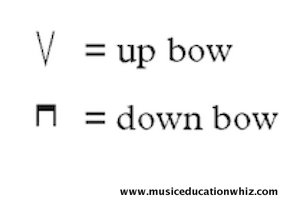
Watch the video below to see an example of a down and up bow:
Point of contact - where exactly we place the bow between the fingerboard and bridge:
Sul Ponticello/Sul Pont - play very close to or right on top of the bridge to produce a glassy sound.
Sul Tasto - play with the bow over the end of the fingerboard to create a very particular sound:
Détaché - separate bows played with an even weight from one end of the bow to the other, moving smoothly from one note to the next.
Portato - when each note under a slur is slightly emphasised:
Spiccato is a technique used on string instruments, where the player bounces the bow on the string, creating a very short staccato:
Sautille - an off-the-string stroke used for very fast passages. The bow bounces naturally:
Ricochet - fast notes all to be played down bow and and staccato:
Barricolage - a bowing style in which there is a repeated note (often an open string) in between changing notes.
Martelé (French)/Martellato - a bowstroke creating a hammered effect by having a strong bite at the start of each note and a moment of silence at the end:
Col legno - playing with the wood side of the bow.
Piano Articulation
Pedals - The pedal on the left is called the 'soft pedal' or the 'una corda' pedal. This pedal creates a softer attack of each note but the sympathetic ringing of the strings not hammered creates a richer tone. The middle pedal is called the 'sostenuto pedal' and holds down the notes you play before you put the pedal down, but not the notes you play after you have put the pedal down. The pedal on the right is called the 'sustaining pedal' or the 'damper pedal' and allows all notes to continue to ring after they have been played. Pianists use this pedal to help them to play legato.
Prepared piano - the piano has been 'prepared' by putting objects such as screws, blu-tac and erasers. This changes the timbre and articulation of each note.
Percussion Articulation
Percussionists have to consider which stick to use, how to hit with the stick, and which part of the stick and percussion instrument to use when working out how to articulate each note. Below are just a few of the techniques that they use to create different articulations.
Rim Shot - striking the head and rim of the drum simultaneously. This can be indicated with a line through the notehead:
Cross stick - the player lays a stick across the drum head and over the rim. The part of the stick over the rim is raised and used to strike the rum. This can be indicated with circles around the slashed noteheads.
Drum Centre or Edge - where it is necessary to specify whether the drum be hit in the centre or on the edge, symbols like those below are used:

Ghost notes - played by striking the drum or cymbal very lightly. These can be indicated by brackets around the noteheads.
Stopped drums - touch the drum after it is struck to stop it from vibrating. This can be indicated with + above the notehead.
Sticking - the composer can indicate which hand a player must use by using 'R' and 'L' above the notes.
Bell or edge - the following symbols can be used or it is left to the discretion of the player:
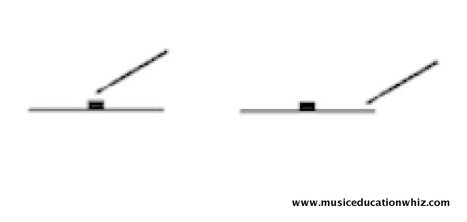
Choked Cymbals: An apostrophe just after the note can be used to tell a player to grab the cymbal immediately after it has been struck.
The hi-hat can be struck closed or with the pedal to give a short, crisp, muted percussive sound called a 'chick'. The player can adjust the gap between the cymbals to get more shimmering or more dry sounds. The player can strike the cymbals with a drumstick to produce short snappy sounds of longer sustained sounds depending on the position of the pedal. Less foot pressure can allow the cyblas to rub together more freely, giving greater sustain and greater volume for accent or crescendo. A closed hi-hat is notated with a x-like cross mark on top of the stave.
An open hi-hat is indicated by a small circle placed above the notehead:
A partially open hi-hat us shown with a vertical line through the circle:
A hi-hat foot splash is created by clashing the hi-hats together forcibly using the pedal, then allowing them to ring.
Martellato is also applied to a handbell articulation technique where the bell is played into the padding of the table, producing a staccato sound:
Home>Music Theory>Articulation

Music Education
Resources by Paula Downes, a lot of music by Andrew Downes
Back to andrewdownes.com
Follow Cynthia Downes on Instagram to keep up-to-date with her blog posts.
If you have performed in any of Andrew Downes' works or come to listen, please share your experiences in the Premieres Blog! Also see what others have said. Thank you so much for your contribution.

